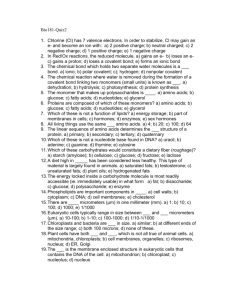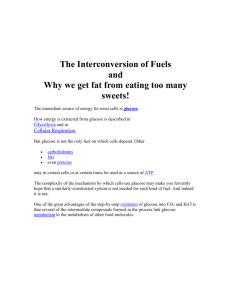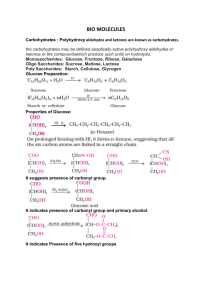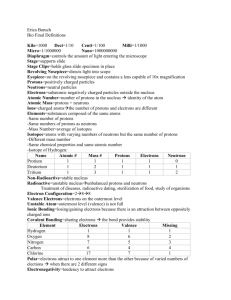Chapter 3- book notes
advertisement
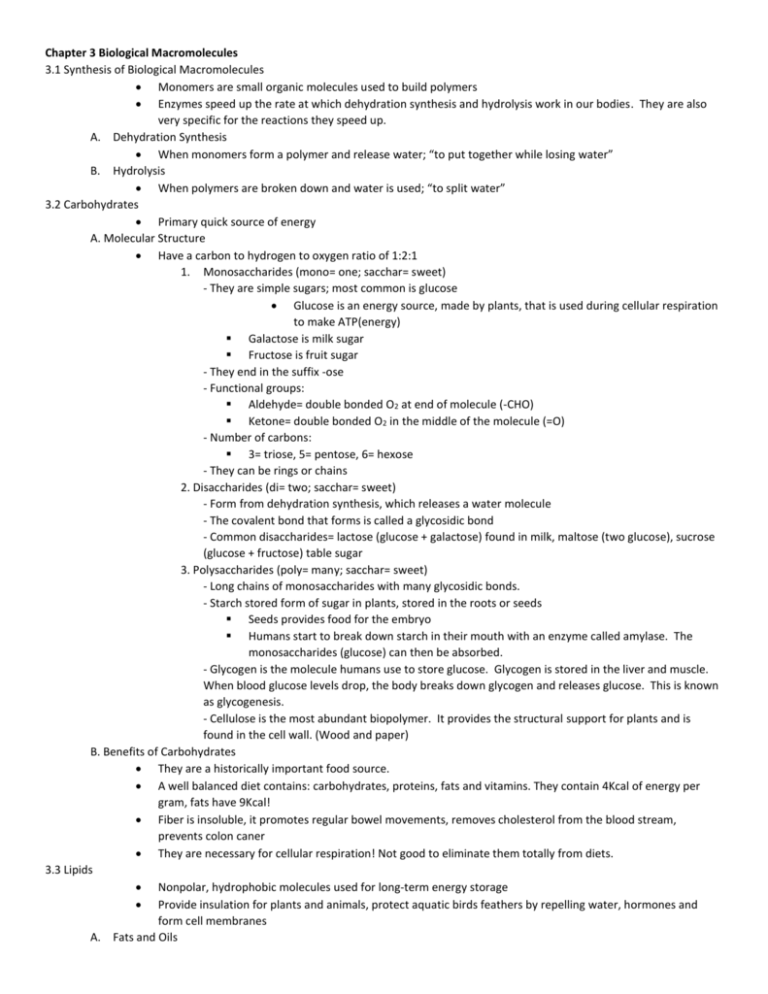
Chapter 3 Biological Macromolecules 3.1 Synthesis of Biological Macromolecules Monomers are small organic molecules used to build polymers Enzymes speed up the rate at which dehydration synthesis and hydrolysis work in our bodies. They are also very specific for the reactions they speed up. A. Dehydration Synthesis When monomers form a polymer and release water; “to put together while losing water” B. Hydrolysis When polymers are broken down and water is used; “to split water” 3.2 Carbohydrates Primary quick source of energy A. Molecular Structure Have a carbon to hydrogen to oxygen ratio of 1:2:1 1. Monosaccharides (mono= one; sacchar= sweet) - They are simple sugars; most common is glucose Glucose is an energy source, made by plants, that is used during cellular respiration to make ATP(energy) Galactose is milk sugar Fructose is fruit sugar - They end in the suffix -ose - Functional groups: Aldehyde= double bonded O2 at end of molecule (-CHO) Ketone= double bonded O2 in the middle of the molecule (=O) - Number of carbons: 3= triose, 5= pentose, 6= hexose - They can be rings or chains 2. Disaccharides (di= two; sacchar= sweet) - Form from dehydration synthesis, which releases a water molecule - The covalent bond that forms is called a glycosidic bond - Common disaccharides= lactose (glucose + galactose) found in milk, maltose (two glucose), sucrose (glucose + fructose) table sugar 3. Polysaccharides (poly= many; sacchar= sweet) - Long chains of monosaccharides with many glycosidic bonds. - Starch stored form of sugar in plants, stored in the roots or seeds Seeds provides food for the embryo Humans start to break down starch in their mouth with an enzyme called amylase. The monosaccharides (glucose) can then be absorbed. - Glycogen is the molecule humans use to store glucose. Glycogen is stored in the liver and muscle. When blood glucose levels drop, the body breaks down glycogen and releases glucose. This is known as glycogenesis. - Cellulose is the most abundant biopolymer. It provides the structural support for plants and is found in the cell wall. (Wood and paper) B. Benefits of Carbohydrates They are a historically important food source. A well balanced diet contains: carbohydrates, proteins, fats and vitamins. They contain 4Kcal of energy per gram, fats have 9Kcal! Fiber is insoluble, it promotes regular bowel movements, removes cholesterol from the blood stream, prevents colon caner They are necessary for cellular respiration! Not good to eliminate them totally from diets. 3.3 Lipids Nonpolar, hydrophobic molecules used for long-term energy storage Provide insulation for plants and animals, protect aquatic birds feathers by repelling water, hormones and form cell membranes A. Fats and Oils B. Fats (triglycerides) are made up of a glycerol and fatty acids, ester bonds (dehydration) hold the glycerol and fatty acids together o Saturated fatty acids- single bonds, solid at room temperature, mostly animal fats o Unsaturated fatty acids- double bond, liquid at room temperature, plant and fish fats Adipocytes- cells that store fats in mammals; plants store fat in seeds 1. Trans fat- artificially hydrogenated fats, extra hydrogen is pumped in to make them solids. They may lead to heart disease and high levels of bad cholesterol (low density lipoproteins, LDLs). 2. Omega Fatty Acids- essential fats that are required, but not made by the human body. They must be supplemented through diet. Omega-3 fatty acids from fish and nuts may reduce the risk of sudden death from heart attacks, reduce blood triglycerides, lower blood pressure, inhibit blood clotting, reduce inflammation and cancer. Waxes Hydrophobic used by animals and plants to cover leaves, which reduces water loss C. Phospholipids Form plasma membranes, the outer layer of cells Made up of: glycerol, 2 fatty acid chains and 1 phosphate group They are amphipathic: o Hydrophilic heads interact with water o Hydrophobic tails do not interact with water Form lipid bilayers, which allow for cell recognition, transport and communication. D. Steroids Fused ring structure, usually four rings linked together Cholesterol is made in the liver and is the precursor to many hormones (testosterone and estradiol), vitamin D and bile salts (break up fats during digestion). 3.4 Proteins One of the most abundant organic molecules in living systems Diverse in function: enzymes, structures, transport in a membrane, toxins Polymers of amino acids(monomer) A. Types and Functions of Proteins 1. Enzymes (catalyst) help breakdown, rearrange and make molecules (We will learn more in lab!!) o Each enzyme is specific to the reaction it catalyzes 2. Hormones (chemical signal molecules) are made by the endocrine system o they regulate physiological processes 3. Denaturation occurs when a proteins shape is permanently changed so that it is no longer functional o Caused by: pH, changes in temperature, exposure to chemicals B. Amino Acids (monomers of proteins) Same structure with different functional groups; amino group, carboxyl group, R group All proteins are made by different combinations of only 20 amino acids; 10 of these are essential because humans cannot produce them and they are obtained through our diet (isoleucine, leucine and cysteine) Polypeptides are made by linking amino acids together in a dehydration reaction called a peptide bond C. Protein Structure 1. Primary Structure is the sequence of amino acid in a polypeptide 2. Secondary Structure local folding of polypeptide (usually held together by hydrogen bonding α- helix β- pleated sheets 3. Tertiary Structure is the unique 3-D structure of the polypeptide, caused by side chain interactions Disulfide linkages, hydrophobic interactions, ionic bonds and hydrogen bonds 4. Quaternary Structure occur when several subunit join together D. Denaturation and Protein Folding Caused by: pH, changes in temperature, exposure to chemicals Reversible if the original primary sequence is not damaged, and when the cause is removed the protein can reform and function properly Irreversible if the original sequence is damaged and loses its function o Heat and eggs Chaperones help with protein folding 3.5 Nucleic Acids Carry the genetic blueprint of a cell and the instruction for the functioning of the cell A. DNA and RNA DNA (deoxyribonucleic acid) is the genetic material found in living things Nucleus of eukaryotes. Wrapped around proteins called histones Within the cell membrane of prokaryotes Genome- entire genetic content of cell RNA (ribonucleic acid) is involved with protein synthesis. Made up of monomers called nucleotides with: Phosphate group Nitrogen base o Divided into purines and pyrimidines! Purines(two ring structure): A, G Pyrimidines(one ring structure): T, C, U o DNA= A, T, C, G o RNA= A, U, C, G Pentose (5 carbon) Sugar o DNA= deoxyribose o RNA= ribose Nucleotides are held together by phosphodiester linkages, where two phosphate groups are lost B. DNA Double Helix Structure Double stranded Two strands of DNA are held together by hydrogen bonding o Sugar and Phosphate are on the outside of the molecule, like the side of a ladder o The nitrogen bases are held in the middle of the molecule, like the steps of a ladder Base pairing: A binds to T C binds to G Replicate occurs by opening the side of the ladder and using each side as a template for a new strand of DNA. Each new double helix contains one parental strand and one new daughter strand C. RNA Single stranded Involved in protein synthesis; transcription(DNA -> mRNA) and translation (mRNA -> polypeptide) o mRNA- messanger= carries message from DNA, made in nucleus when a gene is turned on, it is a complement to a DNA strand, on a ribosome it is read three nucleotides at a time (codon) o tRNA- transfer= carries the correct amino acid to the ribosome for each codon read o rRNA- ribosomal= the major component of a ribosome o miRNA- micro

